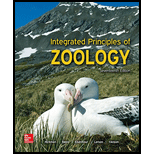
Concept explainers
Describe the evolution of mammals, tracing their synapsid lineage from early amniote ancestors to true mammals. How would you distinguish pelycosaurs, early therapsids, cynodonts, and mammals?
To describe: Mammals’ evolution by outlining synapsid lineage starting from early amniote ancestors to that of true mammals.
Introduction: The living amniotes are classified under two clades, namely, Mammalia, and Reptilia (which include birds, crocodilians, lepidosaurs, and turtles). The mammals, as well as the extinct closest relatives of mammals, contain a single pair of openings in the skull’s temporal region; therefore, they are called synapsids.
Explanation of Solution
The first group of amniotes that diversified extensively into terrestrial habitats is the synapsids. Pelycosaurs were the earliest synapsids found in the early Permian period, and they resembled lizards, but they do not share the features of lizards. From one of the groups of pelycosaurs, therapsids have emerged and are the only group of synapsids that entered the Mesozoic era. Therapsids evolved and diversified into many carnivorous and herbivorous forms. They became extinct at the end of the Permian period. However, one group of therapsids survived and entered into the Mesozoic era, and this group was termed as cynodonts. They diversified and gave rise to mammals during the Triassic period. The evolution of mammals was accompanied by the derivation of many important features. The diversification of mammals started in the Cretaceous period. The modern orders emerged in the Cenozoic era. Large-bodied mammals were greatly diversified during the ice ages of Pleistocene. At the Pleistocene epoch’s end, most of the diversified mammals became extinct due to habitat changes and hunting by modern humans.
To describe: The way in which mammals, cynodonts, early therapsids, and pelycosaurs are distinguished.
Explanation of Solution
Pelycosaurs: They are characterized based on their resemblance to lizards.
Early therapsids: They had an erect gait having upright limbs that is positioned beneath their body. The cerebellum, which is the brain’s muscular coordination center, assumed an extended role.
Cynodonts: They evolved certain characteristics such as powerful jaw musculature, nasal cavity’s turbinate bones, heterodont teeth, and secondary palate.
Mammals: Mammals are differentiated by their mammary glands, hair, ear ossicles, and diphyodont teeth.
Want to see more full solutions like this?
Chapter 28 Solutions
LooseLeaf for Integrated Principles of Zoology
Additional Science Textbook Solutions
Physics for Scientists and Engineers
Physics of Everyday Phenomena
Cosmic Perspective Fundamentals
HUMAN ANATOMY
Campbell Essential Biology (7th Edition)
Genetics: From Genes to Genomes
- please draw in what the steps are given. Thank you!arrow_forwardplease draw in and fill out the empty slots from image below. thank you!arrow_forwardThere is a species of eagle, which lives in a tropical forest in Brazil. The alula pattern of its wings is determined by a single autosomal gene with four alleles that exhibit an unknown hierarchy of dominance. Genetic testing shows that individuals 1-1, 11-4, 11-7, III-1, and III-4 are each homozygous. How many possible genotypes among checkered eagles in the population?arrow_forward
- students in a science class investiged the conditions under which corn seeds would germinate most successfully. BAsed on the results which of these factors appears most important for successful corn seed germination.arrow_forwardI want to write the given physician orders in the kardex formarrow_forwardAmino Acid Coclow TABle 3' Gly Phe Leu (G) (F) (L) 3- Val (V) Arg (R) Ser (S) Ala (A) Lys (K) CAG G Glu Asp (E) (D) Ser (S) CCCAGUCAGUCAGUCAG 0204 C U A G C Asn (N) G 4 A AGU C GU (5) AC C UGA A G5 C CUGACUGACUGACUGAC Thr (T) Met (M) lle £€ (1) U 4 G Tyr Σε (Y) U Cys (C) C A G Trp (W) 3' U C A Leu בוט His Pro (P) ££ (H) Gin (Q) Arg 흐름 (R) (L) Start Stop 8. Transcription and Translation Practice: (Video 10-1 and 10-2) A. Below is the sense strand of a DNA gene. Using the sense strand, create the antisense DNA strand and label the 5' and 3' ends. B. Use the antisense strand that you create in part A as a template to create the mRNA transcript of the gene and label the 5' and 3' ends. C. Translate the mRNA you produced in part B into the polypeptide sequence making sure to follow all the rules of translation. 5'-AGCATGACTAATAGTTGTTGAGCTGTC-3' (sense strand) 4arrow_forward
 Biology (MindTap Course List)BiologyISBN:9781337392938Author:Eldra Solomon, Charles Martin, Diana W. Martin, Linda R. BergPublisher:Cengage Learning
Biology (MindTap Course List)BiologyISBN:9781337392938Author:Eldra Solomon, Charles Martin, Diana W. Martin, Linda R. BergPublisher:Cengage Learning Biology: The Dynamic Science (MindTap Course List)BiologyISBN:9781305389892Author:Peter J. Russell, Paul E. Hertz, Beverly McMillanPublisher:Cengage Learning
Biology: The Dynamic Science (MindTap Course List)BiologyISBN:9781305389892Author:Peter J. Russell, Paul E. Hertz, Beverly McMillanPublisher:Cengage Learning Concepts of BiologyBiologyISBN:9781938168116Author:Samantha Fowler, Rebecca Roush, James WisePublisher:OpenStax College
Concepts of BiologyBiologyISBN:9781938168116Author:Samantha Fowler, Rebecca Roush, James WisePublisher:OpenStax College Biology: The Unity and Diversity of Life (MindTap...BiologyISBN:9781305073951Author:Cecie Starr, Ralph Taggart, Christine Evers, Lisa StarrPublisher:Cengage Learning
Biology: The Unity and Diversity of Life (MindTap...BiologyISBN:9781305073951Author:Cecie Starr, Ralph Taggart, Christine Evers, Lisa StarrPublisher:Cengage Learning Biology 2eBiologyISBN:9781947172517Author:Matthew Douglas, Jung Choi, Mary Ann ClarkPublisher:OpenStax
Biology 2eBiologyISBN:9781947172517Author:Matthew Douglas, Jung Choi, Mary Ann ClarkPublisher:OpenStax





